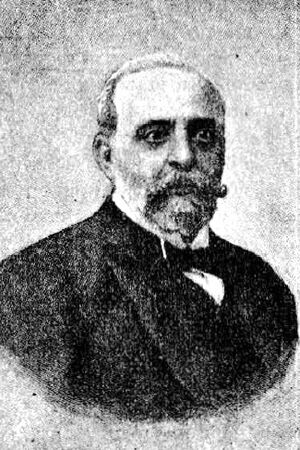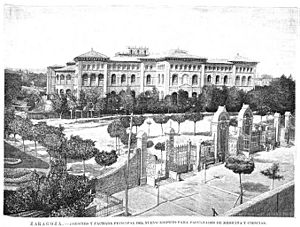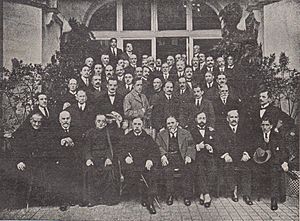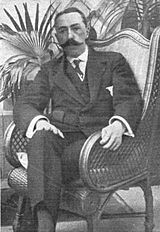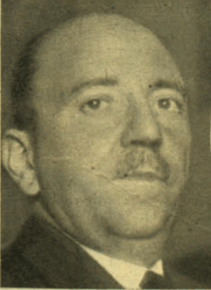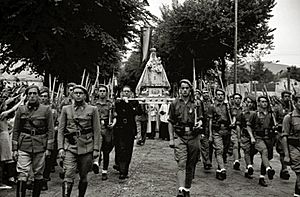Jesús Comín Sagüés facts for kids
Quick facts for kids
Jesús Comín Sagüés
|
|
|---|---|
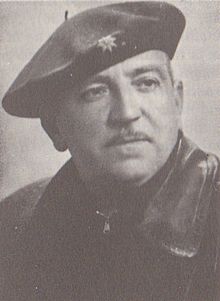 |
|
| Born | 1889 Zaragoza, Spain
|
| Died | 1939 (aged 49–50) Zaragoza, Spain
|
| Nationality | Spanish |
| Occupation | librarian, scholar |
| Known for | politician |
Jesús Comín y Sagüés was a Spanish politician and soldier. He was part of the Carlist movement, which supported a different royal family for Spain. He was elected twice to the Spanish parliament, called the Cortes. Jesús Comín is also known for his important role at the start of the Spanish Civil War. He helped the Nationalist side take control of Zaragoza and a large part of Aragón.
Contents
Jesús Comín's Family and Early Life
The Comín family was well-known in Spain for many generations. Jesús's great-grandfather supported a different king during the First Carlist War. His grandfather, Bienvenido Comín Sarté, was a famous lawyer known as "the lawyer of the poor." He was also a leader in the Carlist movement in Aragon.
Jesús's uncle, Pascual Comín Moya, even became the national leader of the Carlist party for a short time. Jesús's father, Francisco Javier Comín Moya, was a respected professor at the University of Zaragoza. He taught law for 35 years and became the dean of the law faculty.
We don't know much about Jesús's early schooling. He studied at the University of Zaragoza. He was an excellent student in Philosophy and Letters, graduating with honors in 1913. Later, he earned a doctorate degree in Philosophy and Letters.
In 1920, Jesús Comín Sagüés married María Pilar Ros Martínez. They had seven children. Their son, Alfonso Carlos Comín Ros, became famous for trying to combine Communism with Christianity. He was a political prisoner and a leader of Communist parties in Spain. Jesús's grandson, Antoni Comín i Oliveres, is a politician in Catalonia today.
Working as a Public Servant
After finishing university, Comín joined a special group that protected Spain's cultural heritage. In 1915, he became an archivist at the University Library of Zaragoza. He worked as an archivist and librarian for several years, managing important historical documents in Aragon and other places. He was even made director of the Teruel archive in 1921.
Later, Comín also started working at the Faculty of Philosophy and Letters at Zaragoza University. His father was already a part of the academic leadership there. In 1920, he became an assistant professor. He continued in this role for several years.
It's not entirely clear if Comín continued working at the university after the Second Spanish Republic began. Some sources call him a "professor," but others refer to him as a "lawyer." He was known for his wide knowledge in politics, philosophy, literature, and history.
Early Political Life
Growing up in a well-known Carlist family in Aragon, Jesús was used to meeting important party leaders. As a teenager, he joined Carlist youth groups. By 1912, he was a leader of the local student Carlist group.
In the 1910s, the Carlist movement faced some internal disagreements. However, Jesús and his family remained loyal to their chosen king, Don Jaime. Jesús's political career grew when his uncle became the national Carlist leader. Jesús then joined a group working to support Don Jaime.
In 1919, Comín attended a big Carlist meeting called the Junta Magna de Biarritz. This meeting aimed to give the movement new energy. His participation showed his growing importance in the party. In 1920, he ran for a seat in the Cortes from Daroca, Aragon, but he lost. He did not run in the 1923 election because the Carlists believed the system was corrupt.
When the dictatorship of Miguel Primo de Rivera began, political parties were shut down. There is little information about Comín's political activities during this time. He was mostly known for his university work and involvement in Catholic groups. After the dictatorship ended in 1930, Comín became a member of the Carlist regional executive in Aragon.
The Republic Years
In the early days of the Second Spanish Republic, Comín became involved in important Carlist projects across Spain. In 1931, he helped reorganize the Requeté, a Carlist self-defense group, into a military-like force. That same year, he took part in talks with other monarchist politicians to try and unite their efforts.
The new Republic's government was very secular, which brought different Carlist groups together. Comín helped by giving speeches and spreading their message. After the Carlist groups united into the Comunión Tradicionalista, Comín became the head of the Carlist organization in Zaragoza in 1932. He also kept his position in the regional leadership of Aragon.
In 1933, Comín was elected to the Cortes as part of a right-wing group. Three years later, he was re-elected from the same district in Zaragoza. In parliament, he was a very active and strong-willed deputy. He often focused on problems in Aragon, like flood damage or railway issues. He spoke out against anarchist uprisings and the 1934 Asturian revolution. He also argued with other politicians about local government and attacked groups he disagreed with.
Comín openly supported the idea of a "national dictatorship" to lead to a Traditionalist monarchy. He also supported a monarchist alliance. In 1934, the new Carlist leader, Manuel Fal Conde, appointed Comín to the Council of Culture, a group of Carlist thinkers. That same year, Comín became the regional leader for Aragon. He helped the Carlist organization grow quickly in the province and was one of their most active speakers. He also started a local weekly newspaper called El Lunes.
Role in the Civil War
In the last two years before the Civil War, Comín focused on building up the local Requeté organization. By mid-1935, Zaragoza had only two Requeté companies, but a year later, it had grown to a full battalion, making it one of the most organized Carlist centers in Spain.
When the rebellion started in Zaragoza, Comín traveled to Pamplona twice to get more soldiers. He returned with about 1,200 Navarrese Requeté fighters. These Carlist soldiers helped overcome resistance in the city and stopped an Anarchist group advancing from Barcelona. Because of Comín's actions, Zaragoza, which was a stronghold for anarchists, remained under Nationalist control.
After Zaragoza was secured, Comín played a very important political role. He helped turn the uprising in Aragon into a monarchist, very conservative, and strongly Catholic movement. Under his leadership, Carlists replaced republican flags with monarchist ones. He personally brought a painting of the Virgen del Pilar into the city hall, and the city celebrated with religious events.
Comín worked hard to organize new Requeté battalions. The first units of the Tercio de Nuestra Señora del Pilar were formed in late July, followed by another Aragon battalion. Comín joined the command of the Pilar tercio, even though he didn't have military training. He served on the front lines, including when Nationalists re-entered Teruel in early 1938. He was wounded in combat and was known for being very brave, sometimes even taking unnecessary risks.
Comín did not join the main Carlist wartime leadership. However, he got along well with the local Falange party. After the Unification Decree in 1937, which merged different right-wing parties, Comín was appointed a regional leader of the new unified party. He tried to make Aragon a strong Carlist area, influencing local appointments and promoting Traditionalist and Nationalist ideas.
Jesús Comín died in March 1939 in Zaragoza. Most sources say he died in a car accident. Some say he developed lung problems after a car accident at the Teruel front and died from pneumonia.
See also
 In Spanish: Jesús Comín para niños
In Spanish: Jesús Comín para niños



